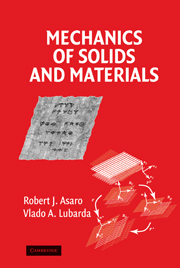Book contents
- Frontmatter
- Contents
- Preface
- PART 1 MATHEMATICAL PRELIMINARIES
- PART 2 CONTINUUM MECHANICS
- PART 3 LINEAR ELASTICITY
- PART 4 MICROMECHANICS
- PART 5 THIN FILMS AND INTERFACES
- 23 Dislocations in Bimaterials
- 24 Strain Relaxation in Thin Films
- 25 Stability of Planar Interfaces
- PART 6 PLASTICITY AND VISCOPLASTICITY
- PART 7 BIOMECHANICS
- PART 8 SOLVED PROBLEMS
- Bibliography
- Index
25 - Stability of Planar Interfaces
Published online by Cambridge University Press: 06 July 2010
- Frontmatter
- Contents
- Preface
- PART 1 MATHEMATICAL PRELIMINARIES
- PART 2 CONTINUUM MECHANICS
- PART 3 LINEAR ELASTICITY
- PART 4 MICROMECHANICS
- PART 5 THIN FILMS AND INTERFACES
- 23 Dislocations in Bimaterials
- 24 Strain Relaxation in Thin Films
- 25 Stability of Planar Interfaces
- PART 6 PLASTICITY AND VISCOPLASTICITY
- PART 7 BIOMECHANICS
- PART 8 SOLVED PROBLEMS
- Bibliography
- Index
Summary
The breakdown of an initially flat, or smooth, surface into one characterized by surface roughness is an important type of phenomena occurring, inter alia, during the growth of thin films or at surfaces of solids subject to remotely applied stress in environments that induce mass removal or transport. In the case of thin films, stresses arise due to lattice mismatch and/or differences in coefficients of thermal expansion. The sources of stress are, indeed, legion but the effect can be to induce roughness, and surface restructuring, that may be either deleterious, or in some cases desirable, if the patterning can be controlled. The phenomena was first studied by Asaro and Tiller (1972) and has since been pursued by others. Our purpose is to develop some of the guiding principles, but we note that the topic is far from being thoroughly worked out. In particular, we make many simplifying assumptions, one being the assumption of surface isotropy. We also ignore some important physical attributes of surfaces, such as surface stress, which have recently been added to the description of surface patterning (Freund and Suresh, 2003).
Stressed Surface Problem
We consider here the phenomena of the breakdown of planar interfaces subject to stress into interfaces characterized by undulated topology. The phenomena is governed by those same driving forces that lead to crack growth and the growth of defects, such as inclusions, that cause internal stresses.
- Type
- Chapter
- Information
- Mechanics of Solids and Materials , pp. 447 - 460Publisher: Cambridge University PressPrint publication year: 2006



